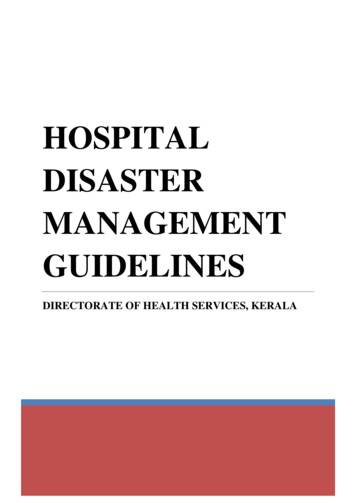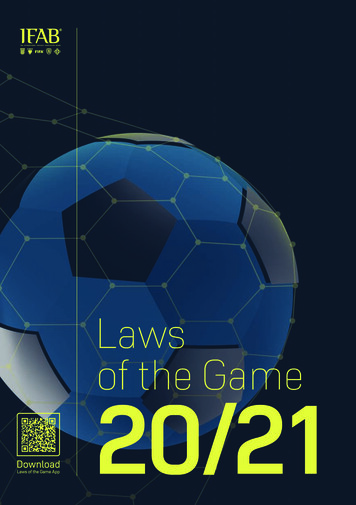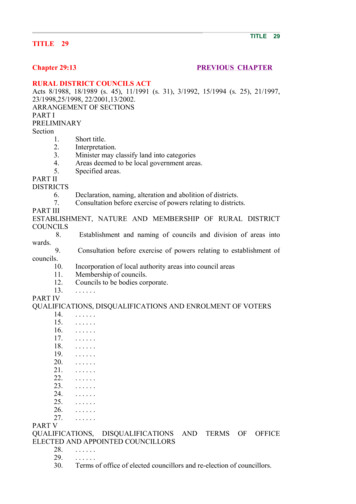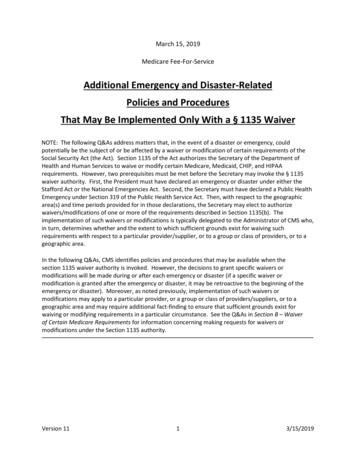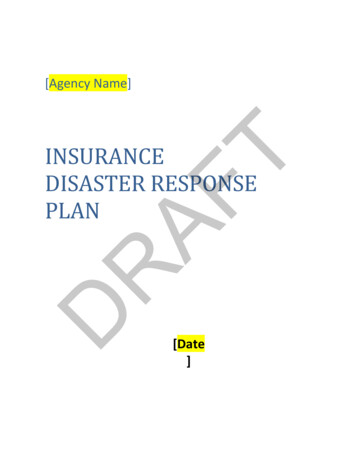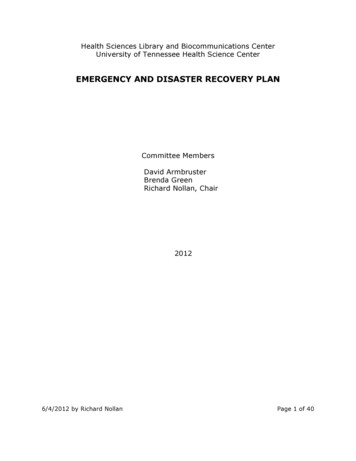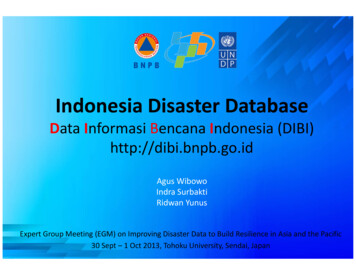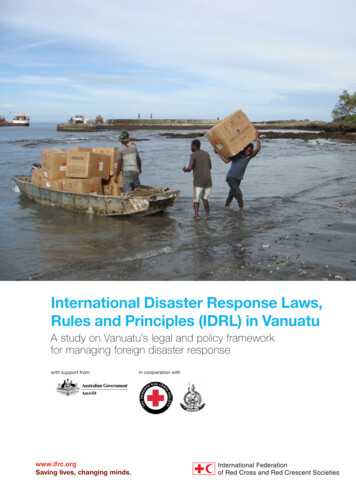
Transcription
International Disaster Response Laws,Rules and Principles (IDRL) in VanuatuA study on Vanuatu’s legal and policy frameworkfor managing foreign disaster responsewith support fromwww.ifrc.orgSaving lives, changing minds.in cooperation with
www.ifrc.orgSaving lives, changing minds.The International Federation of Red Cross and Red Crescent Society’s work is guided byStrategy 2020 which puts forward three strategic aims:1. Save lives, protect livelihoods, and strengthen recovery from disaster and crises.2. Enable healthy and safe living.3. Promote social inclusion and a culture of non-violence and peace.About this reportThis report was commissioned by the International Federation of Red Cross and Red Crescent Societies(IFRC) and the Vanuatu Red Cross Society (VRCS), and prepared by Giovanna Soldateschi, independentlegal consultant. It analyses Vanuatu’s current legal and policy frameworks for addressing the issuesrelated to receiving international disaster assistance.About the IDRL ProgrammeThe IFRC’s “International Disaster Response Laws, Rules and Principles” (IDRL) Programme seeks to reducehuman vulnerability by promoting legal preparedness for disasters. It works in three areas: (1) collabo rating with National Red Cross and Red Crescent Societies and other partners to offer technical assistanceto governments on disaster law issues; (2) building the capacity of National Societies and other stake holders on disaster law; and (3) dissemination, advocacy and research.E-mail: idrl@ifrc.orgWebsite: http://www.ifrc.org/idrl International Federation of Red Cross and Red Crescent Societies, Geneva,Copies of all or part of this study may be made for noncommercial use, providing the source is acknowledged The IFRC would appreciate receivingdetails of its use. Requests for commercial reproduction should be directed to the IFRC at secretariat@ifrc.org.The opinions and recommendations expressed in this study do not necessarily represent the official policy of the IFRC or of individual National Red Crossor Red Crescent Societies. The designations and maps used do not imply the expression of any opinion on the part of the International Federation orNational Societies concerning the legal status of a territory or of its authorities. All photos used in this study are copyright of the IFRC unless otherwiseindicated.P.O. Box 372CH-1211 Geneva 19SwitzerlandTelephone: 41 22 730 4222Telefax: 41 22 733 0395E-mail: secretariat@ifrc.orgWeb site: http://www.ifrc.orgCover photo: Distribution of relief items in response to cyclone Vania in 2011 (Vanuatu Red Cross Society).
International Disaster Response Laws,Rules and Principles (IDRL) in VanuatuA study on Vanuatu’s legal and policy frameworkfor managing foreign disaster response
International Federation of Red Cross and Red Crescent SocietiesContentsAcknowledgementsAcronyms and abbreviations10Executive summary12The legal and institutional framework for disaster response in Vanuatu12Key findings13Summary of core recommendations:15Chapter 1Introduction to the project and its methodology171.1 Background181.2 Scope and methodology18Chapter 2Country background: disaster risks and legal framework202.1 Geography and population212.2 Natural disaster risks212.3 Government and legislative structure23Chapter 3Overview of applicable international and regional standards49253.1 International instruments263.2 Regional organizations and instruments27
International Disaster Response Laws, Rules and Principles (IDRL) in VanuatuA study on Vanuatu’s legal and policy framework for managing foreign disaster responseChapter 4Overview of national laws, policies and plans for disastermanagement304.1 The national disaster response coordination structure314.2 Disaster response operations334.3 Committee system344.4 Achievements and challenges354.5 Recommendations37Chapter 5Declaration of emergency and requests for internationalassistance385.1 Early warnings and declaration of a disaster395.2 Requests for international disaster relief and assistance405.3 Recommendations40Chapter 6Legal status of organizations providing assistance426.1 International organizations with diplomatic status436.2 Vanuatu Red Cross Society436.3 Civil society organizations and international NGOs446.4 Vanuatu Association of Non-Government Organizations (VANGO)446.5 Recommendations45Chapter 7Customs, quarantine and tax arrangements for the entry ofrelief goods and equipment467.1 Customs and import tax exemptions477.2 Other taxes and government levies497.3 Quarantine Measures497.4 Recommendations505
International Federation of Red Cross and Red Crescent SocietiesChapter 8International relief personnel518.1 Entry permits and visas528.2 Recognition of professional qualifications and licenses538.3 Recommendations53Chapter 9International humanitarian transport arrangements549.1 Air transport559.2 Land transport569.3 Maritime transport579.4 Recommendations58Chapter 10Accountability and transparency5910.1 Government expenditures6010.2 Recommendations62Chapter 11Summary of recommendationsOverview of national laws, policies and plans for disastermanagement6364Declaration of emergency and requests for international assistance 646Legal status of foreign entities providing assistance64Customs, quarantine and tax arrangements for the entry of reliefgoods65International relief personnel65International humanitarian transport arrangements66Accountability and transparency66
International Disaster Response Laws, Rules and Principles (IDRL) in VanuatuA study on Vanuatu’s legal and policy framework for managing foreign disaster responseAnnex 1National disaster coordination systemAnnex 2Government department roles and responsibilitiesAnnex 3Organization of national emergency operationsAnnex 4Disaster Management Committee structureAnnex 5List of key referencesAnnex 6Guidelines for the domestic facilitation and regulation ofinternational disaster relief and initial recovery assistance (‘IDRLGuidelines’)6767686869697070717173737
International Disaster Response Laws, Rules and Principles (IDRL) in VanuatuA study on Vanuatu’s legal and policy framework for managing foreign disaster responseAcknowledgementsThe project organizers gratefully acknowledge AusAID and the Australian Red Crossfor their support to the project running costs.The research was primarily undertaken by Mrs Giovanna Soldateschi, an independentlegal researcher. Oversight, review and technical guidance for the project were pro vided by Helga-Bara Bragadottir, Olav Ofstad, David Fisher and Tessa Kelly of the IFRC.At the national level, the legal researcher worked in partnership with the NationalDisaster Management Office (NDMO), in particular with Mr Job Esau, NDMO manager, andMr Peter Korisa, NDMO officer. Furthermore, the legal researcher also greatly benefitedfrom the invaluable information provided by representatives from other governmentdepartments and agencies, civil society organizations, donors and the private sector.9
International Federation of Red Cross and Red Crescent SocietiesAcronyms and abbreviationsCCGCentral Control GroupCHARMComprehensive Hazard and Risk ManagementDCDisaster ControllerDCODevelopment Committee of OfficialsDMDisaster ManagementDMODisaster Management OfficeDRMDisaster Risk ManagementDRRDisaster Risk ReductionDRR-DMDisaster Risk Reduction and Disaster ManagementFOBForward Operational BaseFRANZFrance Australia and New Zealand AllianceFSPVFoundation for the Peoples of the South Pacific VanuatuGeohazardsVanuatu Geohazards Observatory (Department ofGeology and Mines)HFAHyogo Framework for ActionIDRLInternational Disaster Response Laws, Rules and PrinciplesIDRL Guidelines Guidelines for the Domestic Facilitation and Regulation ofInternational Disaster Relief and Initial Recovery Assistance10IFRCInternational Federation of Red Cross and Red Crescent SocietiesIMOInternational Maritime OrganisationMETEOVanuatu Department of MeteorologyMIAMinistry of Internal AffairsMIPUMinistry of Infrastructure and Public UtilitiesMOUMemorandum of UnderstandingMSGMelanesian Spearhead GroupNAPNational Action PlanNAPANational Adaptation Plan of ActionNDCNational Disaster CommitteeNDMONational Disaster Management OfficeNEOCNational Emergency Operation CentreNGONon-Governmental OrganizationORSTOMOffice de la Recherche Scientifique et Technique d’Outre-MerPAAPriorities and Action AgendaPACPublic Accounts Committee
International Disaster Response Laws, Rules and Principles (IDRL) in VanuatuA study on Vanuatu’s legal and policy framework for managing foreign disaster responseAcronyms and abbreviationsPFEMPublic Finance and Economic ManagementRFAPacific Regional Framework for Action on DRR-DMRNDRFRegional Natural Disaster Relief FundSOPACPacific Islands Applied Geosciences CommissionUNDPUnited Nations Development ProgrammeUNICEFUnited Nations International Children’s FundUNISDRUnited Nations International Strategy for Disaster ReductionVATValue Added TaxVPFVanuatu Police ForceVSOVoluntary Services OverseasWHOWorld Health Organization11
International Federation of Red Cross and Red Crescent SocietiesExecutive summaryThis report contains a review of Vanuatu’s legal and policy framework governing situ ations of disaster, with the aim of assessing the level of preparedness to facilitate andregulate foreign humanitarian assistance during a disaster.As its primary analytical lens, the study employed the “Guidelines for the domesticfacilitation and regulation of international disaster relief and initial recovery assist ance” (also known as the “IDRL Guidelines”) as adopted at the 30th InternationalConference of the Red Cross and Red Crescent in 2007. These IDRL Guidelines serve asa practical tool to advise governments on how to prepare their disaster laws and plansfor international relief operations. The Guidelines are annexed to this report.The legal and institutional framework for disaster response in VanuatuThe regulatory framework for disaster risk reduction and disaster management inVanuatu is primarily based on the National Disaster Act 2000, the National Action Planfor Disaster Risk Reduction and Disaster Management 2006-2016, and the NationalDisaster Plan (the most recent review available is for 2009-2010).Vanuatu’s preparedness has never been tested by a major disaster. Most of the legisla tive instruments in operation that would regulate the logistical flow of disaster aid andrelief personnel in such circumstances do not directly address or provide specificallyfor a major national emergency situation. However, many interviewees have presumedthat the directors of the various relevant departments would flexibly interpret existinglaws in order to accommodate emergency aid.The National Disaster Plan, reviewed on a yearly basis, provides for standard operatingprocedures and channels of communications during an emergency. The effectiveness ofthe plan, including the guidelines and procedures contained therein, and their practicalimplementation, has yet to be put to thorough test. This includes processes related toforeign disaster response.It appears that there has been limited dissemination about the existence and contentof the National Disaster Plan. In addition, it is evident that whilst systems for managingand dealing with disasters have been developed by the various government agencies,civil society organizations, the private sector and the donor community, they have beendeveloped independently of each other. This highlights an urgent need for improvedawareness and dissemination of information about the National Disaster Plan amongstthe key stakeholders.The Minister of Internal Affairs is appointed with the primary responsibility for disastermanagement. The National Disaster Committee, chaired by the Directory General ofInternal Affairs, is the lead Government body which coordinates disaster managementand supports the National Disaster Management Office (NDMO) in implementing theNational Disaster Act and associated plans.12
International Disaster Response Laws, Rules and Principles (IDRL) in VanuatuA study on Vanuatu’s legal and policy framework for managing foreign disaster responseExecutive summaryThe Vanuatu Government has improved its disaster management capacity through theconstruction of a new building, which includes a new Emergency Operations Centre.This has brought together key agencies with functional responsibility for disasterrisk reduction (DRR) and disaster management (DM), such as the National DisasterManagement Office (NDMO), Department of Meteorology (METEO), Department ofGeohazards and the Climate Change Unit all under one roof. There are also proposedlegislative changes to the National Disaster Act of 2000 to formalize the amalgamationof the above agencies under a single entity.Key findingsOverview of national laws, policies and plans for disaster managementNeither the current National Disaster Act nor the National Disaster Plan clearly delin eate the roles of government departments in facilitating and regulating foreign disasterresponse in Vanuatu. It is noted that a new draft Disaster Management Act exists, butit has not yet been approved by the Council of Ministers.While the National Disaster Act provides for the preparation of the National DisasterPlan, National Disaster Support Plans, and Provincial Disaster Plans, these plans havenever been properly circulated amongst the key stakeholders, and in some cases theydo not exist.Declaration of emergency and requests for international assistanceAccording to the National Disaster Act and the National Disaster Plan, internationalassistance will be requested once it has been established that the severity of the damageis beyond the capacity of national and provincial available resources in-country. Thisrequirement will need to be determined by the National Disaster Committee (NDC),which will submit through the Minister of Internal Affairs, a formal request for inter national assistance by the Ministry of Foreign Affairs. This is facilitated by the NationalDisaster Committee through the National Emergency Operations Centre (NEOC), when ever a state of emergency is declared.Consultations with concerned agencies indicated that there is substantial confusionas to the expected channels of communication in the event of a disaster, due to lack ofawareness and circulation of the guidelines contained in the annual National DisasterPlan. This has created delays for donor agencies to receive any official requests to acti vate their systems of intervention, which in many cases is needed for authorizationfrom their respective governments to provide support.Legal status of entities providing overseas assistanceThe legal status that potential international disaster responders would enjoy in Vanuatuvaries significantly by category. For international organizations with diplomatic status,there are various legal instruments providing for a variety of immunities, exemptionsand privileges under the Diplomatic Privileges and Immunities Act of 1982. Many othercivil society organizations, NGOs and international relief agencies have memoranda ofunderstanding (MOUs) with the Vanuatu Government. However, there are no regulationsproviding for fast-tracked procedures for granting a legal status in emergency situations.13
International Federation of Red Cross and Red Crescent SocietiesExecutive summaryCustoms, quarantine and tax arrangements for international humanitarian reliefPursuant to the Import Duties Act, relief items may be exempt from import duties andtaxes if they either fall under an international convention or agreement entered intoby the Government of Vanuatu or if they are donated to the Vanuatu Red Cross Societyfor an emergency. The extent of such exemptions, however, remain at the discretion ofthe Director of Customs and Taxes and there are no regulations or provisions for reliefitems in a disaster more generally.The Quarantine Act contains provisions related to diseases affecting people and cattleupon the arrival of vessels. With regard to planes, the Cyclone Support Plan (2009)requires an aircraft’s agent to notify the Department of Livestock and Quarantine serv ices of the expected time of arrival prior to arrival of relief supplies. The Department willthen facilitate the quarantine clearance of the relief supplies at the airport, in accord ance to the quarantine legislation, to ensure that no foreign organisms are introduced.International relief personnelUnder the Immigration Act, relief personnel would need a visa permit unless they arecitizens of a country exempted from visa requirements by an order of the Minister ofInternal Affairs. Alternatively, the legal status agreement or MOU between an organi zation and the Government may contain special exemptions for their personnel.There are no provisions in the Act for an exemption from visa permits for a sepa rate category of person entering the country under a disaster relief programme or anemergency situation. However, it is anticipated that a flexible interpretation would beapplied to the existing Immigration Act to facilitate the processing of foreign personnelentering the country during an emergency situation.No specific provisions were found in Vanuatu laws and policies on the recognition offoreign qualifications (e.g. for medical professionals) of humanitarian personnel. Inpractice, it is presumed that technical experts selected by trusted organizations willbe qualified, and that the organization will bear the responsibility of their actions.International humanitarian transport arrangementsThe Civil Aviation Act of 1999 does not specifically set out procedures for unscheduledforeign humanitarian aircraft bringing in relief supplies. However, Section 41 (1) ofthe Civil Aviation Act states that the Director of the Civil Aviation Authority may, inconsultation with the Minister for Public Utilities, exempt any person, aircraft, aero nautical product, airport or aviation related service from any specified requirement inany ordinary rule, if he or she considers it appropriate.The Ports Act of 1999 states that Port Vila and Luganville are the only designated inter national ports of entry into Vanuatu, and does not provide any exemptions from theusual dues and charges in the event of a disaster. The minister responsible for ports andmarine may, however, authorize the entry into and departure from Vanuatu of vesselsat ports other than those of Port Vila and Luganville. The minister may also, by order,exempt any class of vessel or goods from the payment of dues.14
International Disaster Response Laws, Rules and Principles (IDRL) in VanuatuA study on Vanuatu’s legal and policy framework for managing foreign disaster responseExecutive summaryAccountability and transparencyGovernment expenditures are scrutinized by the Public Accounts Committee (PAC) inParliament, and the Auditor General’s Office has the responsibility to conduct internalaudits of departments. In reality, record keeping and financial accountability remainsa significant challenge despite the role the Department of Finance plays in monitoringexpenditures. PAC has also only recently begun meeting to carry out its role in scruti nizing government expenditures, after many years of not doing so.In terms of comprehensiveness and transparency, its ability to oversee finan cial management and accountability of public funds remains a concern to theGovernment of Vanuatu, as many of the state enterprises and statutory bodieshave not submitted accounts for several years. Currently, each organization con tributing international relief, other than through direct donations to the gov ernment, manages its funds and activities independently and there are no clearcommon standards for the conduct of international relief operations. The MOUbetween the Government of Vanuatu and Vanuatu Association of NGOs (VANGO)signed in 2004 contains the recognition of the respective accountability require ments and processes of the Vanuatu Government and NGOs. Under the MOU,NGOs have multiple accountabilities to partners, donors, memberships and con stituencies, which must be addressed through sound management practices andgovernance structures.Summary of core recommendations:In light of the above, the core recommendations of the report are to:nn Ensure that roles and responsibilities of relevant authorities in disaster response areclearly identified within the National Disaster Act. Provisions should also addressthe reporting lines and procedures in the event of a disaster.nn Include provisions in the National Disaster Plan on issuing a request for internationalassistance which addresses procedures and agencies involved and the content ofsuch a request.nn Further describe the roles and responsibilities of departments in the NationalDisaster Plan to facilitate and regulate foreign disaster response in Vanuatu.nn Include procedures in the National Disaster Act (and/or relevant implementing guide lines/plans) for registering foreign entities (who meet certain eligibility requirements)to obtain temporary legal status.nn Amend the Customs Act (and/or relevant implementing guidelines/plans) to ensurethat priority is given to customs clearance of goods imported for disaster relief duringan emergency.nn Amend the Quarantine Act (and/or relevant implementing guidelines/plans) toensure that priority is given to quarantine inspection of goods imported for disasterrelief during an emergency.nn Amend the Immigration Act (and/or implementing guidelines/plans) to establisha special visa for international relief personnel for multiple entries, for a periodof not less than three months and extendable for the duration of the operation,each time free of charge, as needed for the provision of relief. Holders of thisvisa should also be granted temporary recognition of professional qualificationsunder Vanuatu Law.n n Amend the relevant transport laws to provide for immediate approvals forlanding permission, berthing and clearance of aircraft, marine vessels or15
International Federation of Red Cross and Red Crescent SocietiesExecutive summaryother modes of transportation, that are engaged by registered organizationsand entering Vanuatu for the purposes of disaster relief, provided that theirentry is acknowledged by the authorities in charge of the relief operation.Provide that the fees and duties usually imposed on such aircraft and ves sels will be exempt.nn Include provisions in the National Disaster Act (and/or relevant implementing guide lines/plans) for monitoring the compliance of registered disaster relief agencies withminimum standards based upon the IDRL Guidelines paragraph 4.16
International Disaster Response Laws, Rules and Principles (IDRL) in VanuatuA study on Vanuatu’s legal and policy frameworkfor managing foreign disaster responseChapter 1Introduction to the projectand its methodology
International Federation of Red Cross and Red Crescent SocietiesIntroduction to the project and its methodology1.1 BackgroundIn October 2009, the International Federation of Red Cross and Red Crescent Societies(IFRC), in line with its International Disaster Response Laws, Rules and Principles (IDRL)Programme, offered technical assistance to support the Government of Vanuatu tohave an overview of its legal preparedness for international disaster response. Afterdiscussions, the government accepted the technical assistance and in August 2010,IFRC appointed a legal consultant to take up the task.This project builds on over nine years of global research and consultations undertakenby the IFRC through its IDRL Programme. To date, over two dozen country and regionalstudies have been commissioned to identify problem areas and best practice in theregulation of international disaster relief. They found a common set of legal problemsarising in international operations, due mainly to a lack of legal preparedness at thenational level. These include both barriers to access (including issues with visas, cus toms clearance, duties, taxes and charges, and legal personality problems), as well asfailures of control over the quality, coordination and complementarities of interna tional relief.In 2007, the IFRC spearheaded negotiations on the “Guidelines for the DomesticFacilitation and Regulation of International Disaster Relief and Initial RecoveryAssistance” (“IDRL Guidelines”) which are based on existing international norms andaddress the most common problem areas. In 2007, the states parties to the GenevaConventions unanimously adopted the IDRL Guidelines at the 30th InternationalConference of the Red Cross and Red Crescent.The IDRL Guidelines recognize that it is first and foremost the responsibility of the gov ernment of the affected state to address the humanitarian needs caused by a disasterwithin its borders. This report examines Vanuatu’s legal preparation for undertakingthat responsibility within the context of requesting international assistance.1.2 Scope and methodologyVanuatu is located in one of the most disaster prone areas in the world. As an islandstate, its geographical isolation imposes logistical challenges to international aid reliefin the event of a natural disaster. Rapid and effective response to an emergency is theoverriding objective in any disaster situation.One of the areas often overlooked is the legal preparedness planning for disaster relief.Legal preparedness is having the legal instruments, laws, and regulations in place, tofacilitate the rapid response to a natural disaster by relief agencies and foreign govern ments, and to ensure that logistical support, medical supplies, humanitarian assistanceand other forms of relief are provided quickly and efficiently to those that are affected,whilst also ensuring quality and accountability of the aid providers.This research study was conducted in Vanuatu between August 2010 and December2010. It was managed by the Vanuatu Red Cross Society with technical oversight fromthe IFRC’s Pacific programme for International Disaster Response Laws, Rules andPrinciples (IDRL), which is funded by AusAID.The project intended to assist the Vanuatu Government to make use of the IDRLGuidelines to examine its regulatory framework for international disaster response and18
International Disaster Response Laws, Rules and Principles (IDRL) in VanuatuA study on Vanuatu’s legal and policy framework for managing foreign disaster response1to suggest possible solutions to the common problems that could hamper internationaldisaster response.The terms of reference of this study were to:nn Map and review the legal instruments which are relevant to international responsein case of national disasters.nn Identify the gaps between the domestic law and the practical reality in implementingthe guidelines contained within the international and regional instruments.nn Recommend measures to minimize legal barriers for effective national and interna tional response to national disasters.nn The methodology for this project included the following:nn Research implementation, identification of stakeholders and consultation with them.nn Research and identification of existing legal instruments and guidelines.nn Analysis of research, the law, what is the practical reality and gaps, in particular inlight of the recommendations of the IDRL Guidelines.nn Report preparation and recommendations.nn Preparation for workshop to review the project findings.Major outputs were:nn A study report containing the findings and recommendations.nn A follow-up national IDRL workshop with key stakeholders to review the findings andencourage the development of a multi-stakeholder plan of action for implementingthe recommendations.19
International Disaster Response Laws, Rules and Principles (IDRL) in VanuatuA study on Vanuatu’s legal and policy frameworkfor managing foreign disaster responseChapter 2Country background:disaster risks andlegal framework
International Disaster Response Laws, Rules and Principles (IDRL) in VanuatuA study on Vanuatu’s legal and policy framework for managing foreign disaster response22.1 Geography and populationVanuatu consists of an archipelago of about a dozen large islands and 70 smaller alsoinhabited islands. The total area of Vanuatu is approximately 860,000km², taking intoaccount the Exclusive Economic Zone of 200 miles from the shores. The total landarea is only 12,336km², which represents 1.4% of the total country area. Geologically,Vanuatu is part of the Pacific Ring of Fire and is an island arc resulting from the geo logical activity of the New Hebrides subduction zone.Santo is the largest of the islands and is 4,010km². Malekula follows, with a land areaof 2,069km², and Efate, where the capital city Port Vila is located, has a land area of980km². Erromango, closely follows, with a land area of 900km², however, it is sparselypopulated. Tanna has a land area of 565km², and is ranked as the sixth largest islandafter Ambrym (682km²). Tanna, however, has the highest population density, with 51inhabitants/km².The population of Vanuatu has increased by 47,345 people, from 186,678 in 1999 to234,023 in 2009. This represents a growth rate of 2.3 percent per annum1.2.2 Natural disaster risksVanuatu is vulnerable to a broad range of natural hazards. In particular, it is highlyexposed to the risk of earthquakes, volcanic eruptions and annual cyclonic activity.It is therefore ranked alongside Solomon Islands as among the most disaster pronenations in the region2.2.2.1. Earthquake riskEarthquakes are a frequent occurrence in Vanuatu. About 4,000 earthquakes of mag nitude greater than 4 were recorded in the years between 1961 and 19823. The earth quakes often originate at considerable depth and are therefore not too destructive (largemagnitude but low intensity). Some earthquakes, however, have caused considerabledamage. In 2002, an earthquake of the magnitude of 7.3 on the Richter scale, with it
International Federation of Red Cross and Red Crescent Societies 6 Chapter 8 International relief personnel 51 8.1 Entry permits and visas 52 8.2 Recognition of professional qualifications and licenses 53 8.3 Recommendations 53 Chapter 9 International humanitarian transport arrangements 54 9.1 Air transport 55 9.2 Land transport 56
